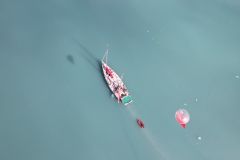Why use a helikite?
Air near the surface, in contact with ice, does not represent the layers where clouds form. The balloon allows scientists to track particles that influence cloud formation and the energy balance of the fjords, a key element for understanding the impact of climate change.
These particles may come from melting glaciers, marine algae, emerging vegetation, or local human activities. They affect cloud formation, the amount of sunlight reflected, and the dynamics of ice and fjords.
Deploying the balloon is only possible thanks to the FOREL crew, who carefully navigate through the ice, sometimes at just 1.5 knots, to move up fjords near Narsaq. Since the first tests and technical adjustments, the balloon has been deployed almost every day during Leg 4.
The data collected at altitude by the helikite are compared with surface measurements from the onboard station, providing a comprehensive view of the connections between the atmosphere and the ocean.
A valuable step for the GreenFjord mission, helping to improve our understanding of climate–cloud–ocean interactions in polar ecosystems.
Photo credit: Steven Le Bras, FOREL team




